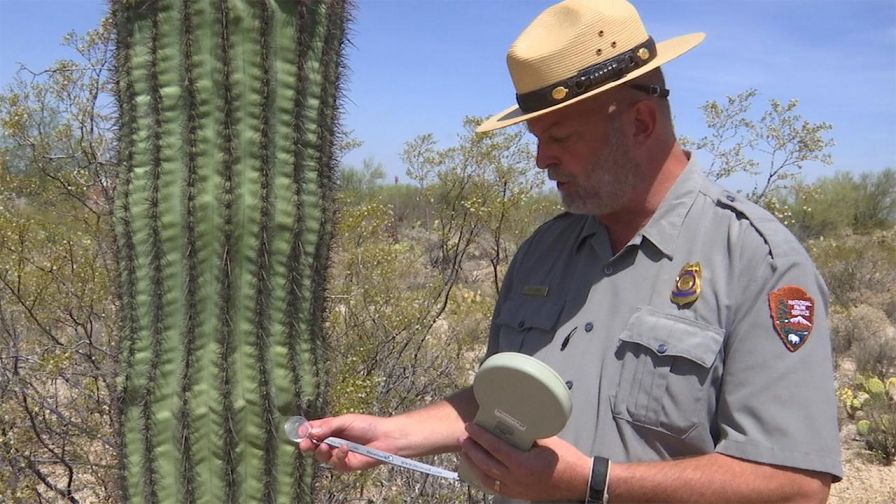JUDY WOODRUFF: Here in the United States, the national parks belong to all of us.
But as Tyler Fingert from the Cronkite School of Journalism at Arizona State University reports, that shared treasure is at risk of being chipped away.
TYLER FINGERT: Across the desert landscape, their silhouette is unmistakable.
At Saguaro National Park near Tucson, cacti are the main attraction for hikers like Jean Gascho.
JEAN GASCHO, Hiker: You feel like you're so much a part of the desert and just surrounded by these beautiful cactuses.
TYLER FINGERT: But the park's namesake cactus is facing a threat from thieves.
KEVIN DAHL, National Parks Conservation Association: It's ironic that we set aside great places like our Saguaro National Park, and people think that they can just come take the iconic cactus for which the park is named.
TYLER FINGERT: Kevin Dahl works with the National Parks Conservation Association.
He says being a cactus thief can be lucrative.
Each one can fetch $100 or more per foot.
KEVIN DAHL: It's absolute robbery, and it's absolute criminal activity.
And it's for profit.
A mature saguaro in a landscape adds something to the value of the home or the business that's for sale or rent.
TYLER FINGERT: Across the country, other parks are facing a similar threat.
Last year, Death Valley National Park says some visitors walked off with fossil footprints.
At Joshua Tree National Park, people have stolen artifacts from old mines.
BILL PARKER, Petrified Forest National Park: Some parks deal with people taking rocks.
Some parks deal with people taking plants and animals.

Places like Mount Rushmore, people take the chips that were created when they created the sculptures.
TYLER FINGERT: Bill Parker leads the Natural and Cultural Resources Team at Petrified Forest National Park.
Here, he says, visitors take small pieces of petrified wood.
BILL PARKER: Some people do still take wood, and we catch them and give them tickets.
But whole areas aren't being stripped clean, as was thought in the past.
TYLER FINGERT: The park turned to photography to test the theory, taking century-old photographs and comparing them to recent photos taken at the same location.
And the results, says Parker, if you look at photos from today, most of the artifacts are still intact.
BILL PARKER: It's a souvenir that people want, but one thing the photography project has showed us is that most people do the right thing.
TYLER FINGERT: Some people have even returned stolen wood, and it ends up here, often referred to as the conscience pile.
Back in Saguaro National Park, to help make sure theft doesn't happen, the National Park Service has turned to technology, putting tiny passive trackers in some of their cacti, allowing them to identify ones stolen from the park.
Of their roughly 1.9 million saguaro cacti, only 1,000 of them are tagged, the ones close to roads and the smaller cacti, those most likely to be stolen.
The trackers, which are similar to pet microchips, don't actively broadcast a signal, so if a cactus goes missing, Ray O'Neil, Saguaro National Park's chief ranger, says the only way to know if it's from the park is to scan it using a reader, making the trackers more symbol than substance.
RAY O'NEIL, Chief Ranger, Saguaro National Park: Our biggest hope is that it's a deterrent, that people recognize that if they steal cacti from Saguaro National Park, that there's a chance that we're going to be able to identify that cactus came from the park.
TYLER FINGERT: While technology is helping to track natural resources, education is still a huge part of keeping parks pristine.
And Kevin Dahl wants to make sure that visitors understand the national parks are saved by the people for the people.
KEVIN DAHL: It's a selfish thing when someone does an act of vandalism or steal something from a national park.
And it's selfish and it's an act against the American public.
TYLER FINGERT: Pieces of American history being taken from some of America's most treasured land.
For the "PBS NewsHour," I'm Tyler Fingert at Saguaro National Park in Arizona.












